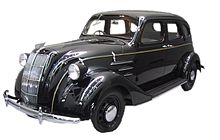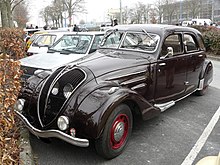Chrysler Airflow
| Chrysler | |
|---|---|
|
Chrysler Imperial CL
|
|
| Airflow | |
| Production period: | 1934-1937 |
| Class : | Upper class |
| Body versions : | Limousine , Pullman limousine , coupe |
| Engines: |
Petrol engines : 4.9–6.3 liters (85–110 kW) |
| Length: | |
| Width: | |
| Height: | |
| Wheelbase : | |
| Empty weight : | |
| Previous model | Chrysler Royal CT, Chrysler Imperial CQ / CL |
| successor | Chrysler Imperial C19 / C20 |
The Chrysler Airflow was a passenger car that Chrysler manufactured from 1934 to 1937. The Airflow was the first major US production car to use the streamlined shape as the basis for a smoother automobile, one that offered less resistance to the wind . Chrysler made the first attempt at a fundamental design change with the Airflow, but this ultimately proved to be one of the biggest failures in automotive history.
Creation of the Airflow project
The Chrysler Airflow arose from the interest of Chrysler engineer Carl Breer in the influence of shapes on the movement of a car in its surroundings. According to Chrysler, Breer's idea came about when he saw geese flying through the air in a V formation. Another source says Breer saw military aircraft maneuvering, while still other sources attribute the idea to Breer's interest in airships and how their shape helps them push through the air.
Breer, along with his work colleagues Fred Zeder and Owen Skelton, began a series of wind tunnel tests , which he carried out with the help of Orville Wright , to determine which of the shapes created by nature would be most suitable for an automobile. Chrysler built a wind tunnel at its Highland Park, Michigan facility and tested at least 50 full-scale models by April 1930. The engineers found that the two-box design common at the time was aerodynamically so inefficient that even better values were obtained if the model was flown from behind! When the engineers applied what they had learned about shapes in the wind, they also investigated ways of building a car with a monocoque construction, on the one hand to create a stiffer body and on the other hand to reduce weight and thus lower the power- to- weight ratio , whereby the streamlined bodywork directed air around it instead of being trapped in upright shapes like grills, headlights, or windshields.
Traditionally shaped automobiles of this time had the typical two-box shape with around 65% of the weight on the rear axle. When the passengers were fully occupied, the weight distribution became even more unbalanced, so that 75% or more of the total weight was on the rear wheels, which led to unsafe driving on slippery roads. The spring rates on the rear wheels of these cars were necessarily significantly higher than those on the front wheels, which gave the passengers a very uncomfortable ride.
An innovative wheel suspension in the new Chrysler Airflow was due to the need for better handling. Compared to traditional cars, the engine was pushed further forward over the front axle and the seats were also moved forward so that the passengers now sat between the axles instead of on the rear axle. The total weight was about 54% on the front axle, which improved to about 50% when the car was fully occupied. This resulted in balanced spring rates, better handling and much greater driving comfort.
Beginnings and changes in airflow
Before introducing the Airflow, Chrysler built a demonstration model with the axles reversed, which made it possible to drive the car "backwards" through Detroit. This demonstration almost caused panic, but gave the audience a clue that Chrysler was up to something really big. The car was like no other American production vehicle of the time.
The airflow, which was heavily influenced by the streamline design, was smooth and low compared to other cars on American roads. The grille was staggered forward and down, forming an arch, while others had a radiator perpendicular to the wind. The main headlights were built directly into the body and solid fenders covered most of the rear wheels.
Instead of a flat windshield, the Airflow had one of two parts that formed a V on both the sides and up and down. The passengers sat in an all-steel body inside the vehicle frame instead of on it. (Many car manufacturers, such as Ford and even Chrysler themselves, still offered bodies in composite construction, in which steel sheets were fastened to a wooden substructure). The front seats were wider than on other cars and the back seat was lower in the vehicle. Overall, the car had a better power-to-weight ratio and at the same time increased torsional rigidity.
The car was presented months before production began; production only peaked in May 1934 with 6,212 units, very late in the model year, so that hardly every dealer could be supplied with at least a single Chrysler Airflow. The production was not prepared for the difficulties that the new construction presented, e.g. B. many different welding processes. The first Airflow shipped had to contend with serious problems, which were mainly the result of faulty manufacturing. According to Fred Breer (son of designer Carl Breer), the first 2,000-3,000 Airflows to leave the factory had many defects, such as motors loosening from their anchors at speeds around 130 km / h.
1934
In 1934, both Chrysler and the mid-range DeSoto brand, located between Plymouth and Chrysler, offered an Airflow. DeSoto was only supposed to offer the Airflow model, but Chrysler didn't want to take any chances and also offered a six-cylinder version of its more conventional 1933 model. The Airflow had an in-line eight-cylinder engine with side-mounted valves and it was available as a 2-door coupé and 4-door sedan.
Within six months of its launch, Airflow began to turn into a sales disaster. General Motors launched an advertising campaign intended to discredit airflow. Most connoisseurs of automotive history, however, confirm that the airflow was largely unsuccessful because people did not like its appearance. The bonnet, "waterfall" grill, headlights and fenders were merged into one continuous shape that was perceived as an "indefinable lump". Although airflow was modern through and through, people were slow to get used to it. At the height of the global economic crisis , the car appeared to many customers to be too progressive and too different from everything previously used. Although the Airflow sold well in its first year of production, it was far surpassed by Chrysler's traditional coupes and sedans. For every 4 Airflow models there were 10 other models and 10,839 Airflows were sold in the first year.
Things were far worse at DeSoto in 1934 than at Chrysler. Without the "standard" model, the sales figures plummeted. And while the Airflow design looked relatively balanced on the longer Chrysler, the DeSoto appeared rather short and chubby.
There were also rumors that the "newfangled" body was unsafe, which was largely wrong. In a promo movie shown in movie theaters, an empty airflow was pushed off a rock in Pennsylvania and fell over 30 m; when it was put back on its wheels, it was dented, but still clearly recognizable, and could drive on.
1935
Disappointed about the lack of customer interest, Chrysler reacted with body changes and designed the front of the vehicle more according to the public's taste. The most important change in 1935 was a slightly tapered radiator grille that replaced the "waterfall" example from 1934.
Chrysler also introduced a standard model with an all-steel body, which was offered as Chrysler Airstream , or DeSoto Airstream . The Airstream became popular and sold much better than the Airflow.
The production numbers of the Chrysler Airflow fell below 8,000 units in 1935; there were about four Airstreams for one airflow.
1936
In 1936, the Airflow lost its curved back because a trunk was added. The grille was also emphasized more. Only one Airflow model, the 4-door Imperial sedan (C-10), broke the 1,000 mark and was produced 4,259 times. Otherwise, the number of Airflow sank to 6,275 units, whereas the Airstream sold over 52,000 units this year. 1936 was the last year in which Chrysler's top model Imperial was manufactured as an Airflow.
1937
In its last year of production there was only one model of the Airflow, a 2- or 4-door sedan. A total of 4,600 units were produced this year until the model series was discontinued. That year, an Airflow sedan became the official car of the President of the Philippines , Manuel Quezon . The historic car was restored in 1978 and is on display in Quezon City .
aftermath


Design elements of the Airflow were adopted from a few other brands. Probably the first on the market was Volvo with the PV36 introduced in 1935 . The "02" series from Peugeot with types 202 , 302 and 402 is one of the best known and longest built . Introduced as the 302 and 402 in 1936, the last version of the 202 added in 1938 was built by 1949. The Toyoda AA was also presented in Japan in 1936 . The forerunner of the Toyota was based on an Airflow-style prototype from 1935, the A1 . Other versions were built in small numbers until the 1940s.
Chrysler's attempt to set itself apart from other automakers with Airflow clearly failed. The lack of market success ensured that the company took a more conservative path with future models and the designers were even more suspiciously controlled by the technicians than before. Brilliant designs by chief designer Raymond Dietrich also fell victim to this. Until the presentation of Virgil Exner's " Forward Look " in 1955, Chrysler styling was conservative and conventional.
Today most cars are built using the wind tunnel, and cars like the aerodynamic Ford Thunderbird or the Ford Taurus sell very well.
Model cars
Although the Airflow did not appear as a model car as often as z. B. the Cord 810 or the Duesenberg model J, there are still many die-cast models of him; a pre-war model was sold on eBay in 2006 for US $ 5,000, roughly the same price as the original in its day. A white metal model (No. 7) of the Airflow Sedan from 1934 on a scale of 1:43 was released by Brooklin Models , which is now out of print . The long inactive brand Rex Toys also offered the Chrysler Airflow Sedan from 1935 in 1:43 in different colors as well as a taxi, "Fire Chief" and police vehicle. A 1:32 scale die-cast model of a 1936 Airflow Sedan from Signature may still be available.
literature
- George H. Dammann: 70 Years of Chrysler. Crestline Publishing / Glen Ellyn IL, Osceola WI 1974, ISBN 0-912612-06-1 . (English)


